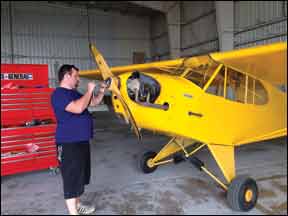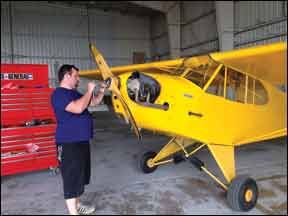Even with the aviation economy only crawling along, I’m constantly amazed by the technological changes. Cessna has hung a diesel engine on a production airplane, Rotax engines are mainstream, lean of peak operations—largely forgotten since the 1940s—have been rediscovered and are saving owners thousands on fuel and maintenance costs. And those aren’t even new.

Constant change has always been reality. Yet, over the last generation, the combination of computers, and more and more creative people using them, has probably caused the pace of change to increase.
Many of our professions have dealt with change by requiring recurrent training of its members—doctors, lawyers, pilots, flight instructors—because failure to keep up has adverse affects on those served by the professionals.
There is a respected group of professionals who work in a high-tech field where errors can mean death, yet they have absolutely no obligation to undergo recurrent training of any sort—A & P maintenance technicians. While A & P candidates undergo rigorous training and must pass written and practical examinations, once they get their certificates, they never have to do anything to keep them current and effective.
Back in the 1960s and 1970s, most of the airframe and engine manufacturers put on free one- or two-week classes aimed at those maintaining their products. Shops sent their mechanics and kept framed completion certificates prominently displayed on the wall to showcase that their techs were up to date on the latest.
By the late 1980s, the big aviation downturn meant that most of those classes went away. Financial pressures on shops ratcheted up, and they couldn’t afford to let their mechanics have the time off to go to what schools were left.
The one-person shops have had a very hard time. They’re busy, owners will complain about prices even if the proprietor cuts the shop rate to a dollar an hour, and they’re expected to be able to work on anything from a new Cessna 172 through an exotic two-seater from the 1940s.
The result is that too many maintenance technicians have not kept up with what technology is teaching about the care and feeding of airplanes and engines. Within the last year I’ve had techs tell me, in all seriousness, that lean of peak operations cause burned valves (not possible, temperatures go down when lean of peak) and that there’s no need to use a borescope because you can tell when to replace a cylinder with a compression check. That one was not familiar with the engine manufacturers’ service bulletins warning against making a cylinder replacement decision based just on compression checks.
One unneeded cylinder replacement due to lack of current knowledge on the part of a mechanic is expensive. Worse is that the top overhaul, replacement of all cylinders, is almost never necessary—a sick cylinder is not infectious—yet it is still done with alarming frequency.
Maintenance technicians are professionals. Part of being a professional is recognizing that continuing education in one’s field is an essential part of carrying on that profession.
I’m not crazy about regulations, but I recognize that there are some things we humans won’t do unless compelled. Recurrent training is one of them. Lawyers don’t go to continuing education classes unless required. Most Part 91 pilots only do the very bare minimum recurrent training mandated by regulations, a biennial flight review. So, for the maintenance profession, it’s time that the insurance companies start the process by requiring some degree of continuing education for A & Ps in order for a shop to get insurance and that the FAA mandate some recurrent training—perhaps a weekend class every two years—in order to exercise those certificates. The upside is obvious, the downside is minimal. —Rick Durden


